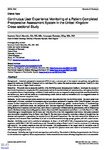Continuous User Experience Monitoring of a Patient-Completed Preoperative Assessment System in the United Kingdom: Cross-sectional Study
| dc.contributor.author | Maramba, Inocencio Daniel | |
| dc.contributor.author | Chatterjee, Arunangsu | |
| dc.date.accessioned | 2022-03-18T13:49:38Z | |
| dc.date.available | 2022-03-18T13:49:38Z | |
| dc.date.issued | 2022-01-06 | |
| dc.identifier.issn | 2563-6316 | |
| dc.identifier.issn | 2563-6316 | |
| dc.identifier.other | e31679 | |
| dc.identifier.uri | http://hdl.handle.net/10026.1/18953 | |
| dc.description.abstract |
<jats:sec> <jats:title>Background</jats:title> <jats:p>Anesthetic preoperative assessment (POA) is now a common part of the surgical care pathway, and guidelines support its routine use. MyPreOp (Ultramed Ltd) is a web-based POA system that enables remote assessments. Usability is a key factor in the success of digital health solutions.</jats:p> </jats:sec> <jats:sec> <jats:title>Objective</jats:title> <jats:p>This study aims to assess the usability of the MyPreOp system through patient feedback, investigate the amount of time it took for patients to complete the POA questionnaire and the factors that influenced completion time, and explore the effect on completion times of implementing a validated eHealth usability scale, as compared to using a simple but unvalidated usability evaluation scale, and to test the feasibility of administering a more detailed usability evaluation scale in a staggered manner so as not to unduly increase completion times.</jats:p> </jats:sec> <jats:sec> <jats:title>Methods</jats:title> <jats:p>In this cross-sectional study, anonymized data sets were extracted from the MyPreOp system. The participants were adults (aged ≥18 years), scheduled for nonurgent surgical procedures performed in hospitals in the United Kingdom, who gave consent for their anonymized data to be analyzed. Data collected included age, gender, American Society of Anesthesiology (ASA) physical classification status, and completion time. Two user experience evaluations were used: in Phase 1, 2 questions asking about overall experience and ease of use, and in Phase 2, a previously validated usability questionnaire, with its 20 questions equally distributed among 5 succeeding patient cohorts. There were 2593 respondents in total (Phase 1: n=1193; Phase 2: n=1400). The median age of the participants was 46 years, and 1520 (58.62%) of the 2593 respondents were female. End points measured were the median completion times in Phase I and Phase II. The data were collected by extracting a subset of records from the database and exported to a spreadsheet for analysis (Excel, Microsoft Corporation). The data were analyzed for differences in completion times between Phase I and Phase II, as well as for differences between age groups, genders, and ASA classifications.</jats:p> </jats:sec> <jats:sec> <jats:title>Results</jats:title> <jats:p>MyPreOp scored well in usability in both phases. In Phase 1, 81.64% (974/1193) of respondents had a good or better experience, and 93.8% (1119/1193) found it easy to use. The usability rating in Phase 2 was 4.13 out of a maximum of 5, indicating high usability. The median completion time was 40.4 minutes. The implementation of the longer usability evaluation scale in Phase 2 did not negatively impact the completion times. Age and ASA physical status were found to be moderately associated with increased completion times.</jats:p> </jats:sec> <jats:sec> <jats:title>Conclusions</jats:title> <jats:p>MyPreOp rates high in both user experience and usability. The method of dividing the questionnaire into 5 blocks is valid and does not negatively affect completion times. Further research into the factors affecting completion time is recommended.</jats:p> </jats:sec> | |
| dc.format.extent | e31679-e31679 | |
| dc.format.medium | Electronic | |
| dc.language | en | |
| dc.language.iso | en | |
| dc.publisher | JMIR Publications | |
| dc.subject | digital health | |
| dc.subject | preoperative assessment | |
| dc.subject | self-completed patient questionnaires | |
| dc.subject | usability | |
| dc.subject | user experience | |
| dc.subject | web-based | |
| dc.title | Continuous User Experience Monitoring of a Patient-Completed Preoperative Assessment System in the United Kingdom: Cross-sectional Study | |
| dc.type | journal-article | |
| dc.type | Journal Article | |
| plymouth.author-url | https://www.ncbi.nlm.nih.gov/pubmed/37725545 | |
| plymouth.issue | 1 | |
| plymouth.volume | 3 | |
| plymouth.publication-status | Published online | |
| plymouth.journal | JMIRx Med | |
| dc.identifier.doi | 10.2196/31679 | |
| plymouth.organisational-group | /Plymouth | |
| plymouth.organisational-group | /Plymouth/Faculty of Health | |
| plymouth.organisational-group | /Plymouth/Faculty of Health/Peninsula Medical School | |
| plymouth.organisational-group | /Plymouth/REF 2021 Researchers by UoA | |
| plymouth.organisational-group | /Plymouth/REF 2021 Researchers by UoA/UoA23 Education | |
| plymouth.organisational-group | /Plymouth/Research Groups | |
| plymouth.organisational-group | /Plymouth/Research Groups/Institute of Health and Community | |
| plymouth.organisational-group | /Plymouth/Users by role | |
| plymouth.organisational-group | /Plymouth/Users by role/Academics | |
| dc.publisher.place | Canada | |
| dcterms.dateAccepted | 2021-10-19 | |
| dc.rights.embargodate | 2022-3-19 | |
| dc.identifier.eissn | 2563-6316 | |
| dc.rights.embargoperiod | Not known | |
| rioxxterms.versionofrecord | 10.2196/31679 | |
| rioxxterms.licenseref.uri | http://www.rioxx.net/licenses/all-rights-reserved | |
| rioxxterms.licenseref.startdate | 2022-01-06 | |
| rioxxterms.type | Journal Article/Review | |
| plymouth.funder | E-Health Productivity & Innovation in Cornwall (EPIC2)::European Regional Development Fund |


